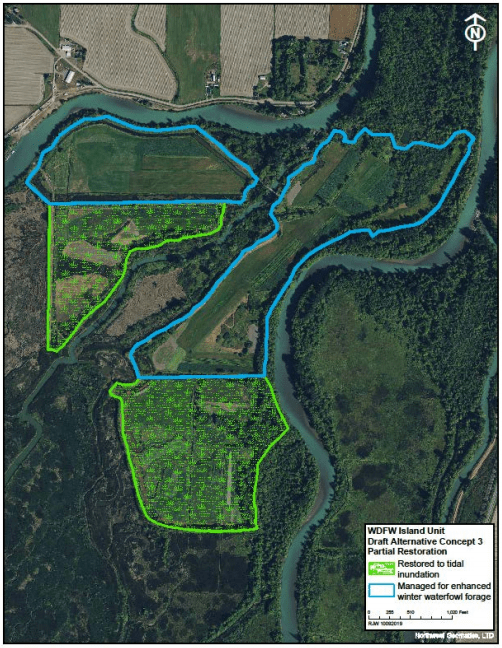Habitat Proposals For Popular Skagit Waterfowling Area Out For Comment
THE FOLLOWING IS A PRESS RELEASE FROM THE WASHINGTON DEPARTMENT OF FISH AND WILDLIFE
The Washington Department of Fish and Wildlife (WDFW) is inviting the public to provide input on a potential estuary restoration project on the Skagit Wildlife Area Island Unit.

The Island Unit, accessible only by boat, covers approximately 268 acres on two islands in a tidally influenced reach of the South Fork Skagit River within the 17,000-acre Skagit Wildlife Area. Dikes and tide gates on the site allow the production of winter waterfowl forage and freshwater wetland management, making the Island Unit a popular destination for waterfowl hunting.

WDFW is considering an estuary restoration project on the Island Unit to respond to changes at the site and the broader landscape, including aging tide gates and dikes, anticipated sea level rise, and shifting habitat needs. The department is assessing several options that range from no restoration to restoring the entire 268-acre site.
To evaluate options, the department is conducting an alternatives analysis, which is a planning tool used to evaluate a range of choices relative to a set of common criteria. WDFW is evaluating alternatives based on state requirements and policies, fish and wildlife needs, community values, as well as input from the Island Unit Advisory Group, tribes, and the public.
“We value the contributions of the Island Unit Advisory Group over the past year as we developed four alternatives and the criteria to evaluate them,” said Brendan Brokes, North Puget Sound Director for WDFW. “Now, we’re excited to share these ideas with the broader community and gather their input.”
The Island Unit is a priority area for restoration because it was historically a tidally influenced estuary that provided critical rearing habitat for juvenile Chinook salmon. The Skagit Chinook Recovery Plan identifies estuarine habitat as the highest priority for recovering salmon in the area. Estuary restoration would benefit Chinook salmon and shorebirds and could also benefit Southern Resident Killer Whales and recreational fishing opportunities.
To review the proposed alternatives and provide feedback, visit the WDFW Island Unit project webpage.
People can submit comments on the draft alternatives analysis report through Dec.16 online, via email, or by mail to:
Washington Department of Fish and Wildlife, North Puget Sound Regional Office
Attn: Seth Ballhorn
16018 Mill Creek Boulevard
Mill Creek, WA 98012-1541
People can also provide comments at an online open house scheduled for Wednesday, Dec. 2 from 6 to 8 p.m.
The department will select an alternative in early 2021. For questions or more information, contact Seth Ballhorn at Seth.Ballhorn@dfw.wa.gov or 360-791-4987.
WDFW currently manages the Skagit Wildlife Area to preserve and protect habitat, restore native plant communities, maintain healthy populations of game and non-game species, and provide diverse recreational opportunities for the public.
